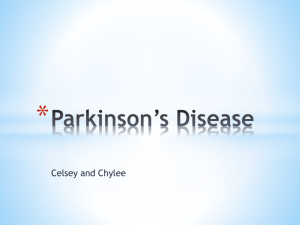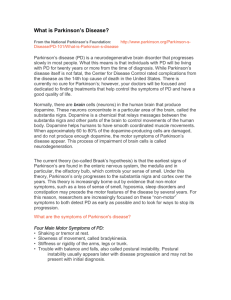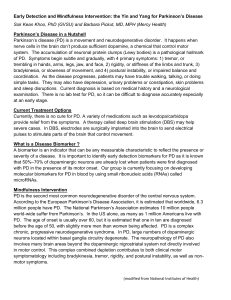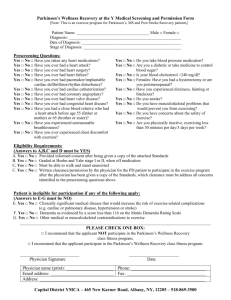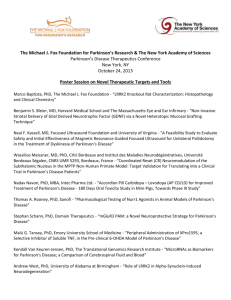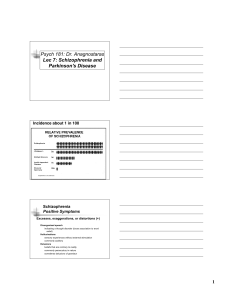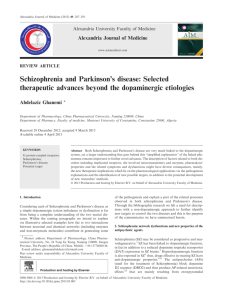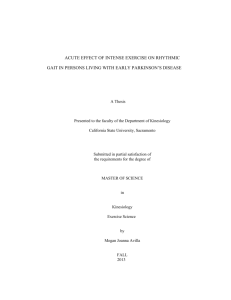BEMER Therapy for Parkinson's Disease
advertisement
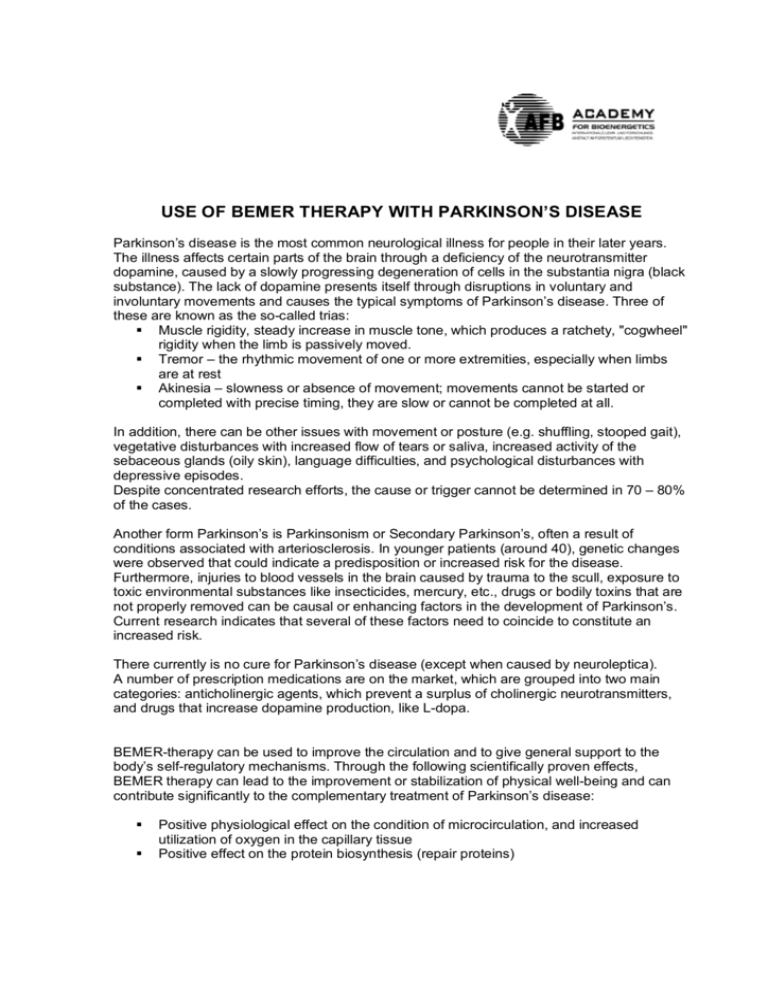
USE OF BEMER THERAPY WITH PARKINSON’S DISEASE Parkinson’s disease is the most common neurological illness for people in their later years. The illness affects certain parts of the brain through a deficiency of the neurotransmitter dopamine, caused by a slowly progressing degeneration of cells in the substantia nigra (black substance). The lack of dopamine presents itself through disruptions in voluntary and involuntary movements and causes the typical symptoms of Parkinson’s disease. Three of these are known as the so-called trias: § Muscle rigidity, steady increase in muscle tone, which produces a ratchety, "cogwheel" rigidity when the limb is passively moved. § Tremor – the rhythmic movement of one or more extremities, especially when limbs are at rest § Akinesia – slowness or absence of movement; movements cannot be started or completed with precise timing, they are slow or cannot be completed at all. In addition, there can be other issues with movement or posture (e.g. shuffling, stooped gait), vegetative disturbances with increased flow of tears or saliva, increased activity of the sebaceous glands (oily skin), language difficulties, and psychological disturbances with depressive episodes. Despite concentrated research efforts, the cause or trigger cannot be determined in 70 – 80% of the cases. Another form Parkinson’s is Parkinsonism or Secondary Parkinson’s, often a result of conditions associated with arteriosclerosis. In younger patients (around 40), genetic changes were observed that could indicate a predisposition or increased risk for the disease. Furthermore, injuries to blood vessels in the brain caused by trauma to the scull, exposure to toxic environmental substances like insecticides, mercury, etc., drugs or bodily toxins that are not properly removed can be causal or enhancing factors in the development of Parkinson’s. Current research indicates that several of these factors need to coincide to constitute an increased risk. There currently is no cure for Parkinson’s disease (except when caused by neuroleptica). A number of prescription medications are on the market, which are grouped into two main categories: anticholinergic agents, which prevent a surplus of cholinergic neurotransmitters, and drugs that increase dopamine production, like L-dopa. BEMER-therapy can be used to improve the circulation and to give general support to the body’s self-regulatory mechanisms. Through the following scientifically proven effects, BEMER therapy can lead to the improvement or stabilization of physical well-being and can contribute significantly to the complementary treatment of Parkinson’s disease: § § Positive physiological effect on the condition of microcirculation, and increased utilization of oxygen in the capillary tissue Positive effect on the protein biosynthesis (repair proteins) § § Improved micro-hemodynamic conditions for the first steps of immunological processes, and thereby in indirect strengthening of the body’s own defense mechanisms Positive effect on the vegetative nervous system BEMER therapy is a complex method that optimizes energy production by the individual cells (ATP) through improved circulation and increased oxygen utilization, thereby contributing to the overall regulation of the body’s metabolism. It is therefore an important and essential foundation for strengthening the body’s self-healing mechanisms, supporting other treatment measures in the environment of a holistic approach, and increases effectiveness of clinical treatment concepts. User recommendations for BEMER therapy with Parkinson’s Disease § § Twice daily on the mat according to the basic program At bedtime on the mat with level 1 Please note: Supplements of alkaline-based minerals for neutralization of the tissues are recommended to improve the responsiveness to therapeutic measures, as well as oxygen therapy for patients with pronounced symptoms. Removing heavy metal deposits in the body may also be beneficial. Recent research shows the importance of daily “training” with appropriate physical therapy, as well as the extensive integration of the patient into the “domestic” duties, with emphasis on tasks involving small motor skills. Continuous employment of these skills can form an important catalyst to improving the body’s own production of dopamine, and provide the patient with a longer period of agility, strength, coordination skill and thus quality of life. Our documentation of user studies with Parkinson’s patients has been based mainly on individual reports and therefore no scientific conclusions are possible at this time. We do know, however, that patients receiving BEMER therapy attest to an improvement in general well-being – based on a variety of parameters – and that there is an improvement in gait with an ability to walk longer distances independently. Patients with Parkinson’s disease definitely will need long-term therapy. Literature and studies: Klopp, R.: Magnetfeldtherapie: Komplementär-therapeutisch sinnvoll oder Unsinn? Institut für Mikrozirkulation Berlin (2005) Michaelis, H.: Ärztliche Anwenderstudie 09/03. Akademie für Bioenergetik (2003) Michels-Wakili, S., Kafka W.A.: BEMER 3000-typisch gepulste elektromagnetische Felder niedriger Energie reduzieren Zahnarztangst (2003) Please note: Broad acceptance of medical products generally takes several years. We are committed by law to advise you that the effectiveness of electromagnetic fields is still being discussed controversially and has not been commonly accepted. © Akademie für Bioenergetik - www.afb-us.com


